Perhaps most people think of herbs, when it comes to creating natural medicinal products.
However, the world is surrounded by plenty of trees that can also be used to make powerful medicines to help aid in our health, without destroying the tree.
The first step in creating these medicinal options is to identify which trees can help produce products to be used in aiding our health.
But before I share the types of trees and their benefits, there are a few things to consider first, before jumping in full throttle.
A Guideline to Foraging
Before you start, you should do some research on good tips in coming up with the most productive product that will help you and your family… and preserve nature as best you can.
For example, take a look at these tips:
- When it comes to removing bark, it’s best to remove it from a dead branch, rather than on the tree trunk. Lost bark on a trunk can lead to an infestation of unwanted pests or diseases.
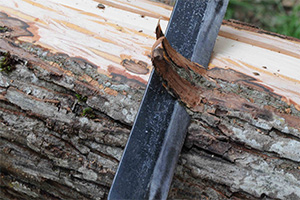 Use the ⅓ rule; ⅓ to harvest, ⅓ for wildlife, and ⅓ to reproduce.
Use the ⅓ rule; ⅓ to harvest, ⅓ for wildlife, and ⅓ to reproduce.- Make sure you are 100% certain on the identity of the tree.
- Do not waste nature, just use the amount it takes to create your product and leave the rest to thrive.
There are other tips and guidelines you can probably come up with along the way as you make your medicinal product. If so, share them with us all!
Various Ways to Use a Tree for Medicinal Products
Both bark and leaves of a tree can be used for making medicinal products. For example, take a look at the following:
If you are using leaves, simmer about 2 teaspoons in 1 cup of water, for approximately 20 minutes. If you plan on using it as a foot soak or wound wash, make the solution stronger by doubling the amount of leaves used.
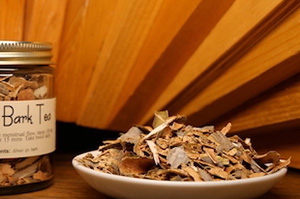 To make teas from bark, you can simmer 2 teaspoons of bark per 1 cup of water for about 20 minutes.
To make teas from bark, you can simmer 2 teaspoons of bark per 1 cup of water for about 20 minutes.
Make sure to strain it before drinking. Leftover teas can be stored in an airtight glass container, and stored in the fridge up to a week.
To make a salve, steep the leaves or bark in warm oil, for about 15-20 minutes, then strain it. Melt some beeswax over a hot water bath, then add 3 tablespoons of the wax for every 1 cup of the oil.
Related: DIY Natural Pain Relief Salve
Types of Trees and How to Use Them
Here are 14 different trees and how they can be used to help with your health:
Alder
The leaves and bark can be used to make tea, which can be good to wash wounds, aid with tonsillitis, fever, or dry up breast milk. The sap can help relieve itching.
You can make bags from cheesecloth and fill them with warmed leaves to help with chronic skin issues.
Apple
Apple trees and their fruit can be used in many ways, such as…
- The bark can be used to make tea, which could help with fevers.
- The fruit is rich in iron, magnesium, potassium, and Vitamins B, B2, and C and can be used to aid in both diarrhea (eating peeled apples) and constipation (stewed and unpeeled).
- Consumed on a regular basis, apples have been known to enhance restful sleep.
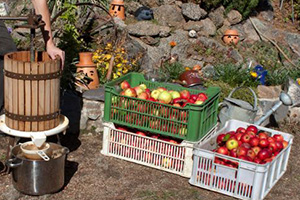 Apples can help clean the liver by reducing the acidity in the stomach.
Apples can help clean the liver by reducing the acidity in the stomach.- Raw apple cider can help correct and restore bacteria in the bowels, after taking a course of antibiotics.
- If you add horseradish and garlic to apple cider, you can either drink it, or use it as an external wash to help clear the skin.
Ash
The leaves and tips of the twigs from the spring growth of ash trees are sometimes used to make tea, which can be used as a laxative.
It can also help with jaundice, gout, or rheumatism.
Beech
Use the bark to make tea to help with the following:
- Lung ailments, such as tuberculosis
- Cleanse the blood
- As a wash for poison ivy
You can also use the leaves in poultices for frostbite or burns.
Birch
The bark of a black birch is on the sweet side, and the yellow birch tends to have a wintergreen flavor.
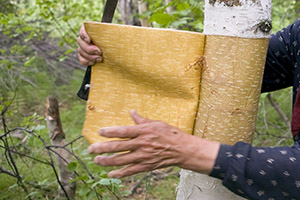
A twig or leaf can be used to make tea to aid in the following:
- Constipation
- Oral sores
- Bladder and kidney sediments
- Gout
- Rheumatic pain
Make it stronger and more of it, to soak in a bath to help with skin conditions such as psoriasis, eczema.
Related: How To Make Fuel From Birch
Cedar
Tea produced from the twigs and bark of a cedar tree is high in vitamin C.
It’s often used for treating chest colds, fevers, the flu, and rheumatic pain.
Elder
The berries of an elder can be used to make a tea that can help benefit the blood and lungs. The elder tree can also help with…
- The leaves can be used to make a salve or poultice for healing the skin.
- Root bark tea can help clear congestion and relieve headaches.
- Used in a tincture, the flowers of the tree help to lower a fever by inducing perspiration.
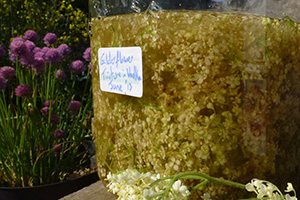 The flowers are also used to create a special water to help with sunburn or blemishes.
The flowers are also used to create a special water to help with sunburn or blemishes.- Cold tea made from the flowers can help reduce inflammation, when placed on the eyes.
- Elderflower oils can be used to make soothing balms.
Slippery Elm
People have used the Slippery Elm tree medicinally, in the following ways:
- As a paste, it can be applied to flesh wounds, or directly on the abdomen to help draw out a fever.
- Made into a tea, it can aid in healing bones.
- The powdery bark added to water can turn into a jelly, which can help soothe urinary and bowel complaints, as well as sore throats.
Related: 10 Medical Home Emergencies and How to Manage Them
Maple
The leaves and bark from maple trees have been used to make teas and poultices, to help treat the following:
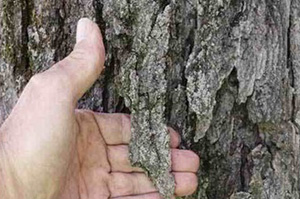 Sore eyes
Sore eyes- Diarrhea
- Swollen limbs
- Kidney infections
- Colds and coughs
- Bronchitis
The leaves of a young maple can also be used to make massage oil, which when used can help soothe sore muscles.
Oak
Internal remedies are best made from white oak, where any oak can help with external washes. The bark and leaves have tannins, which can have antiviral and antiseptic properties.
White oak bark teas, in particular, can be beneficial in treating the following:
- Chronic mucus discharges
- Chronic diarrhea
- Sore throats
And white oak also can be made into a gargle to soothe sore throats, or a wash for issues with the skin such as burns, poison ivy, and other wounds.
Pine
As an evergreen, the pine tree is often more easy to access all year round in colder climates. And that is great, because it can be beneficial in making homemade antiseptics, which can be used as a wound wash.
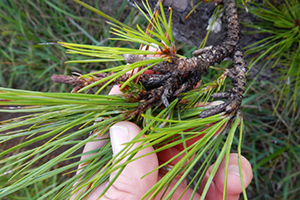
Also, the needles and twigs, especially from the white pine, can be simmered to make a Vitamin C-rich tea. This would be a good way to help with coughs, colds, and sore throats.
And, some people have taken a pine bath to help soothe sore muscles and improve their circulation.
Poplar
Native Americans used poplar to help treat toothaches and gum swelling.
Also, the buds in springtime were used to make salves to treat various ailments, such as:
- Skin issues
- Sore muscles
- Sprains
- Headaches
- Eczema
- Gout
- Coughs
Decoctions from various parts of the poplar tree have been used to treat the following:
- Rheumatic pains
- Scurvy
- Bladder and kidney ailments
- Phlegm
Walnut
Walnut husks are anti-fungal, and are rich in manganese, which has skin-healing properties. For example, rub fresh walnut husks directly onto ringworm.
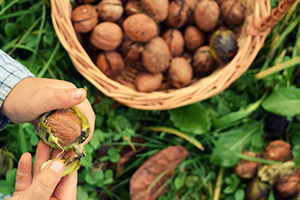
You can also use bark that has been dried and powdered to apply to the wound to help reduce swelling and speed healing.
Walnut leaf tea can aid in increasing circulation, energy, and digestion, and fresh bark is known to help relieve headaches when applied to the temples.
Willow
Willow bark contains salicylic acid. This is aspirin in its natural form.
It’s typically harvested in spring, when the buds are just beginning to form. When made into tea, it can treat pain, fever, and inflammation.
When it’s used externally, it helps to clean minor skin issues such as cuts, scrapes, and poison ivy. Or as an oil, you can soak your arthritic joints to help reduce pain and swelling.
Also, some Native Americans used the bark for tea to treat diarrhea.
Now that you are aware of a few trees that have been considered medicinal for years, you might want to look into properly harvesting them, so you can stock your own personal medicine cabinet!
You may also like:
How to Make Anti-Inflammatory Band-Aid Using Plantain
Stop Spending Money on Painkillers and Grow This Plant Instead (Video)
The Police and Military when SHTF – Friend or Armed Foe?

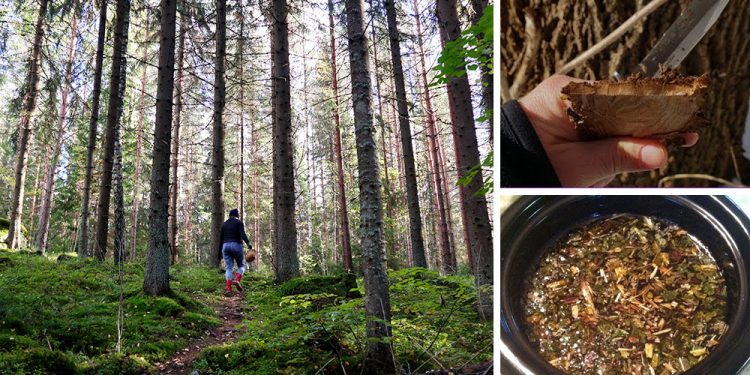














The elder must be distinguished from the elderberry. Every part of the elderberry (except the berries) is highly toxic to humans.
I don’t know what part of the US, you’re in. I’m in Oregon and we have two elderberry trees – Blu and red. The blue produce fruit that is edible. Good for treating flu, can be made into jam or use the berries in muffins and other baking.
Smaller branches of blue elderberry have a very spongy inner pith that can be pushed out with a straightened coat hanger wire to create a straw. This can be used to harvest maple tree sap when collecting to make maple syrup.
On the other hand, red elderberry fruit is very poisonous. Birds won’t even touch them. The inner bark is extremely poisonous, as is the pith. Don’t use this specie for anything that I know of.
Lots of folks on Etsy are selling red elderberry seeds. I wonder why.
Russ Red Elderberries are only piosonous if not cooked properly, and you should cook blue elderberries as well, I have heard both sides to the blue ones, I look at it as why risk it ?
“Beech
Use the bark to make tea to help with the following:
Lung ailments, such as tuberculosis”
Just how does beech tea help with tuberculosis? How about lung cancer? That is a lung ailment too. Does beech tea treat lung cancer?
TB was a scourge of mankind until the discovery of penicillin. Lung cancer covers a wide variety of different cancers all of which entail a variety of treatment protocols.
Beech tea may help alleviate the symptoms of bronchitis but that is a far cry from helping TB. It may help alleviate the coughing associated with TB but does absolutely nothing for treating the underlying cause of the cough.
I can remember reading a book by Betty McDonald, the famous authoress of the book “The Egg and I” which was made into a movie it was so popular. She wrote a follow along book called “The Bug and I” I can remember reading it when I was confined to bed with rheumatic fever when I was about 8 years old. It describes her days in a TB sanitarium being treated for pneumo-turberculosis. In addition to lung TB there was also TB associated with other organs, and bones. It is a bacterial infection. Penicillin cured it quite handily. Penicillin almost succeeded in wiping TB from the face of the earth. At the time of her confinement the standard treatment was to collapse one lung to allow it “to rest” with the patient breathing with only one lung. That isn’t too difficult although it does limit one’s participation in marathon races. After one lung was cleared of the bacillus it was re-inflated and the other lung was collapsed to repeat the process. I don’t know if it was the collapsing that aided in the body overcoming the bacterial infection or it was the days of rest, a good diet, clean air and sanitary surroundings that was the curative source AND, most importantly of all, I think, NO SMOKING.
A statement such as “helps with tuberculosis” says nothing. Does the beech solution kill the bacillus? Does it aid in breathing somehow? Does it stifle coughing? How does it accomplish any or all of those problems associated with TB?
If it is so useful in treating pneumo-TB, why did we have to wait until the invention of penicillin to overcome the scourge of TB? In the 50s immigrants coming to this country had to be screened for TB. It was still that much of a scourge in countries other than the U.S. If beech tea was so helpful, why was TB still so prevalent in the rest of the world even as late as 1958? I don’t know when we stopped screening for TB for immigrants as I stopped being involved in immigration problems in 1959.
That is the crux of what turns me away from herbal medicines. First is the grandiose claims of all the disease entities most herbal remedies are alleged to “treat”. Secondly is the vagueness of the recipes for the magic potion. At least this article give some semblance of an accurate recipe although two teaspoons of leaves is still not precise enough for medicinal purposes. How about 5 grams of finely chopped leaves for the recipe? Finely chopped leaves release more of any palliative ingredient than crumpled up leaves, so which is it, two teaspoons of finely chopped leave or two teaspoons of crumpled up leaves? Even finely chopped is too amorphous to be used as a medicinal guideline. My finely chopped may be a lot finer than your finely chopped.
There is no question that herbal remedies are better than doing nothing. Always bear in mind, however, that the placebo effect is 30% of “cures”. So even dancing and chanting and shaking gourd rattles will work in 30% of the patients being “treated”.
It does say in the beginning to do more research. This article is just a beginners guide. Definitely raises a lot of questions, some of which you mention.
The herbal supplement business in the U.S. has been deeply perverted by the profit motive. Probably half the supplements sold are just raw herb, completely unprepared and useless. Most expert websites are scams selling anything they think they can sucker you into. Well meaning people with more enthusiasm than knowledge haunt you in the aisles of the health food store.
One of the most interesting sources of herbal knowledge I’ve run across is Red. His comments are from several generations of very mixed family and his years of personal experience, I’ve never seen wrong info from Red, it is all from his personal experience.
My favorite reference on herbal remedies is by Michael Moore (no, not the obnoxious libtard), Los Remedios, Traditional Herbal Remedies of the Southwest. It’s in English, around 12 bucks on Amazon.
It bothers me when authors with no knowledge of a subject happily publish lists of facts they read somewhere, that list probably just a list of other lists. Beech tea cures TB, okay, sounds good to me…
So many of the diseases that have been completely eliminated or almost eliminated here like TB in the US are now simply walking across the border. I wonder just how prepared our medical professionals are to deal with all of this on top of COVID19 and given the current state of our economy.
LCC: Old saying, God heals the patient, the doctor is only there to amuse the patient. With the new, improved way they’re doing medicine, the witchdoctor is again a viable alternative.
I have to wonder why they’re so against tobacco. It’s a healer if used right. Most ‘flavored’ cigarettes started out as medicines. Given that most of our official Materia Medica came from American Indian herbals, tobacco should be in the fore. The only one to claim it causes cancer was Hitler, who then told researchers to prove it. Like we say, demonicas cannot stand the smell, and Hitler grew nauseous when someone smoked near him. With biologists and other scientists in the family, I learned a fard fact, researchers are human with less reason to be honorable than most.
Kiowa Indians milked their mares and suffered little TB. Highlands Inuit in Canada were forbidden to hunt and forced to subsist on flour and other ‘white’ foods and died like flies to TB, diabetes, and other things. niio
My mother was an herbalist, slippery elm is indeed excellent for many things, for example, it can heal stomach ulcers; however, do NOT use when pregnant, it can cause the fetus to abort.
The native elderberry in the Eastern U.S. is Sambucus canadensis, it is generally smaller than black elder but similar enough to have been considered a subspecies of black elder until recently. The dark purple berries and white flowers are good to eat but have to be cooked 1st, boiling, frying, etc… Black elder is a European tree widespread on the West coast, Sambucus nigra. Red elderberry, Sambucus racemosa, is similar to black elder and elderberry except with red fruit. All have edible berries and flowers that have to be cooked. An extract made from the berries is widely available to treat colds and flu and is said to be very effective. You need to make a positive identification of elderberry with a book or online reference, there are several shrubs with similar berries that are not edible. Love to see their masses of white flowers in the second half of spring.
Why not make wine? My grandmother use to make elderberry wine for medicinal purposes.
Correct me if I am wrong buti always heard Sambucus Canadensis was west coast and Sambucus nigra was east coast. Here in the Willamette Valley of Oregon we find the S. Canadensis all over a d the S. raceamosa especially on the sides of the roads heading from the valley over the coastal range on the way to the left coast
Not wrong, S. nigra is an introduced tree and can be found anywhere, S.canadensis is an eastern U.S. native but could be planted anywhere, and nigra and canadensis almost certainly hybridize, canadensis used to be listed as a variety of nigra. The scientists will clear it all up one of these days using DNA instead of flower parts to classify plants. Wish we had the raceamosa here, that red fruit is pretty.
I took a 6-week course presented by a local naturalist who specializes in edible and medicinal plants of the PDRK. He demonstrated by eating some elderberries that they are edible here in the coastal regions of the PDRK without further ado. He also added that the seeds were poisonous without being cooked but that in small quantities (undefined) they weren’t strong enough to be fatal or even make one sick enough to wish they were fatal. He likened them to apple seeds which also contain cyanide but in such small dosage that consuming a small quantity (again undefined) would not prove fatal.
Unfortunately, the class covered so many plants in such a short time that aside from some undecipherable notes I didn’t gain much from it. I did learn one thing however which is that buckwheat is now considered native to the PDRK. That identified a plant that I had always wondered about. Traveling up Hwy 395 to Mono Lake there are vast natural fields of what looked like wheat. I always wondered what they were. Lo and behold: Buckwheat ! I learned that not only is it now considered native to the PDRK which it originally was not, but it grows wild in numerous locales in great quantity. There are several varietals of it but they are all edible.
I hope I never have to use that bit of information but it is handy to have tucked away deep in my memory banks.
Judge: with a ground squirrel problem, one great thing about the elderberry is, the roots are so toxic one bite and the critter is fertilizer. We can raise the blue here *S. Canadensis), but red, a European native (as far as I know) seems to need more water. niio
Maybe I am wrong, but the photo in the Birch section, the way the bark is being removed, I believe is called” girdling” and will kill any tree.
Bark is supposed to be removed in strip, vertically. Not too much as it exposes the tree to all insects and diseases.
Like I said, maybe I am wrong, but seems like a bad idea to me.
Peace,
MadFab
Correct, vertically.
The Birch tree’s bark can be removed without killing (girdling) it as the trees bark is many layered. It comes off in very thin sheets and as long as you cut through the layers carefully you can get the outer two layers and still have bark over the core of the trunk without hurting the tree. Birch bark is waterproof as if you’ve ever seen a Birch log laying in the forest you can, if it’s been there long enough, step on it and see the the inner core of the trunk is decayed to, basically, pulp. That’s the reason many American Natives made their canoes and some types of shelters from it but in those applications they were “girdled” because they needed it as thick as possible for strength. I use it to cover the backs of Plains Indian horse bows (covering the back of the limbs) that are backed with sinew to protect the sinew/glue layer, those strips of Birch bark are as thin as a piece of paper. And attractive.
What a beautiful craft, bow making.
Thanks for your reply, Dave. It certainly cleared up a misconception that more than one of us had.
I had always heard that girdling a tree was a guaranteed killer. Period. End of Sentence. Once again, the only general rule is that there is no general rule.
LCC: who the freek is giving you all these thumbs down?
I like the information but……it would be good to post color pictures to make identification of the the mentioned trees and easier process. This would make the information even that much more valuable.
I agree, but articles need to be short. As long as we’re given botanical names, ISD should be easy to look up online. niio
Pine needle tea the answer to covid vaccine shedding / transmission? Learn about suramin, shikimic acid and how to make your own extracts.
Source: https://thetruthaboutvaccines.com/pine-needle-tea/
Note: Drinking Pine Needle Tea will deactivate/neutralize the spike proteins in the covid19 vaccines.
Rob: Yes! But, every nation who followed Germany’s tests said the same, it was conclusive that smoking tobacco was one of the best ways to kill covid. Non-smokers caught it at a 28% average, but smokers at a 0.2% average. niio